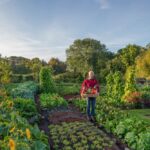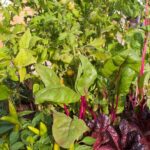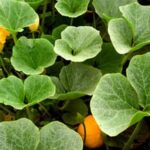Vegetable gardening container protection is essential for ensuring the health and productivity of your plants. Whether you are growing vegetables in a small urban space or want to extend your growing season, protecting your containers from pests, diseases, and environmental factors is crucial. In this article, we will discuss the importance of container protection in vegetable gardening and provide valuable tips and strategies for keeping your plants healthy.
When it comes to vegetable gardening in containers, choosing the right containers is the first step towards ensuring plant protection. Factors such as material, size, drainage, and insulation play a crucial role in creating a conducive environment for your vegetable plants. We will explore these factors and provide guidance on selecting the best containers for your specific needs.
Furthermore, we will delve into common pests and diseases that can affect container gardening and how to identify and mitigate them effectively. Understanding these potential threats is vital for developing a proactive approach to plant protection. Additionally, we will discuss best practices, natural remedies, and protective coverings for maintaining the health of your vegetable plants in containers. With our comprehensive guide, you can learn how to maintain thriving vegetable gardens in any container setup.
Choosing the Right Containers for Vegetable Gardening
When it comes to vegetable gardening, choosing the right containers is crucial for the success and protection of your plants. There are several factors to consider when selecting containers for your vegetable garden. First, you’ll want to choose a container that is large enough for the specific type of vegetable you plan to grow. For example, larger vegetables like tomatoes and peppers will require bigger containers, while smaller plants like lettuce and herbs can thrive in smaller pots.
In addition to size, it’s important to consider the material of the container. Different materials have different properties that can affect the health and protection of your plants. For example, terracotta pots are porous and allow for better airflow and drainage, but they may dry out more quickly than plastic or ceramic containers. Plastic pots are lightweight and retain moisture well, but they may not offer as much insulation in extreme temperatures.
Another factor to consider when choosing containers for vegetable gardening is mobility. Some gardeners prefer containers with wheels or handles for easy transport, especially if they need to move their plants indoors during inclement weather or pest infestations. Additionally, considering the aesthetic appeal of the containers can enhance the overall look of your vegetable garden.
It’s important to take into account these factors when selecting containers for your vegetable garden as they can make a significant impact on the protection and overall success of your plants.
| Factor | Description |
|---|---|
| Size | Choose a container large enough for specific type of vegetable |
| Material | Consider properties like airflow, drainage, insulation, and moisture retention |
| Mobility & Aesthetic Appeal | Look for containers with wheesl or handles for easy transport; Consider aesthetic appeal enhancing overall look. |
Common Pests and Diseases That Can Affect Container Gardening
When it comes to vegetable container gardening, there are several common pests and diseases that can pose a threat to the health and productivity of your plants. Some of the most prevalent pests include aphids, whiteflies, spider mites, and cutworms, while common diseases to watch out for are powdery mildew, blight, and root rot. These pests and diseases can cause damage to your vegetable plants, affecting their growth and yield if left untreated.
Aphids are small insects that feed on the sap of plants, causing stunted growth and distorted leaves. Whiteflies also feed on plant sap and can spread harmful viruses to your vegetables. Spider mites are another common pest in container gardening that can cause yellowed leaves and webbing on the plant. Cutworms, on the other hand, are caterpillars that chew through stems at soil level, causing wilting or death of young seedlings.
In terms of diseases, powdery mildew is a fungal infection that appears as a white powdery substance on the leaves of plants. Blight is a bacterial or fungal disease that causes dark spots on leaves and can lead to rapid decay of foliage.
Finally, root rot is a condition caused by waterlogged soil or overwatering, which leads to rotting roots and poor plant health. Taking proactive measures against these pests and diseases is crucial for maintaining healthy vegetable plants in containers.
| Pest/Disease | Effect |
|---|---|
| Aphids | Stunted growth and distorted leaves |
| Powdery Mildew | White powdery substance on leaves |
| Spider Mites | Yellowed leaves and webbing on the plant |
Best Practices for Protecting Vegetable Plants in Containers
When it comes to protecting vegetable plants in containers, there are several best practices that can help ensure the health and productivity of your garden. Whether you are dealing with pests, diseases, or environmental factors, taking proactive steps to protect your plants is essential for a successful harvest.
Here are some best practices for protecting vegetable plants in containers:
1. Regular inspection: Inspect your plants on a regular basis to check for signs of pests or disease. Look for holes in the leaves, yellowing or browning foliage, and any unusual markings on the plants. Early detection can help prevent problems from spreading.
2. Proper watering and feeding: Proper watering and fertilizing can help to keep your plants strong and healthy, making them less susceptible to pests and diseases. Make sure to water your plants consistently and provide them with the nutrients they need for optimal growth.
3. Use quality soil mix: Choosing the right soil mix for container gardening is crucial for plant health. A high-quality potting mix will provide good drainage and aeration, which can help prevent root rot and other issues.
In addition to these best practices, it’s important to consider other factors such as proper spacing between plants in containers, providing adequate light and ventilation, and choosing the right types of vegetables for container gardening. By implementing these best practices, you can help protect your vegetable plants from common threats and maintain a thriving garden.
Natural Remedies for Pest and Disease Control in Container Gardening
Container gardening is a popular and convenient way to grow vegetables, herbs, and fruits in limited spaces such as balconies, patios, and small yards. However, protecting the plants from pests and diseases is crucial to ensure a successful harvest. While chemical pesticides and fungicides are widely available, many gardeners prefer natural remedies for pest and disease control in container gardening. Here are some effective natural remedies to keep your vegetable plants healthy:
- Neem oil: Neem oil is a natural insecticide that can be used to control common pests such as aphids, mealybugs, and spider mites. It also has antifungal properties that can help prevent diseases like powdery mildew.
- Diatomaceous earth: This natural substance is made from fossilized remains of diatoms and works by dehydrating and damaging the exoskeletons of insects. It is effective against pests like slugs, snails, and ants.
- Companion planting: Some plants have natural repellent properties that can help protect your vegetable garden from pests. For example, planting marigolds around your vegetable containers can deter nematodes and other harmful insects.
In addition to these natural remedies, it’s important to practice good cultural practices such as proper watering, adequate sunlight, and soil management to prevent diseases in container gardening. Avoiding overwatering can help prevent root rot and fungal infections, while providing adequate sunlight can promote healthy plant growth.
By incorporating these natural remedies into your container gardening routine, you can effectively control pests and diseases without resorting to chemical interventions. This will not only protect your vegetables but also promote a healthier environment for both yourself and beneficial insects in your garden.
Types of Protective Coverings for Container Gardening
When it comes to protecting your vegetable plants in containers, using protective coverings can make a significant difference in the health and yield of your crops. There are several types of protective coverings available, each with its own set of pros and cons. Understanding the options will help you make an informed decision on the best approach for your vegetable gardening container protection.
Row Covers
One popular option for protecting container-grown vegetables is the use of row covers. These covers are typically made of lightweight, breathable fabric that creates a physical barrier between your plants and pests. Row covers can also provide some protection from harsh weather conditions such as wind and frost. However, one downside to using row covers is that they may need to be removed during flowering to allow for pollination unless using insect-pollinated crops.
Cloches
Cloches are another type of protective covering that can be used in container gardening. These bell-shaped or dome-like structures are usually made from glass, plastic, or even metal. Cloches work by creating a warm microclimate around individual plants, protecting them from cold temperatures and promoting early growth. While cloches offer excellent protection and can extend the growing season, they may require careful monitoring to prevent overheating on warmer days.
Netting
Netting is a versatile protective covering that can be used to protect container-grown vegetables from birds, insects, and other pests. There are different types of netting available, including bird netting and insect netting, which can be draped over containers or suspended on frames.
One of the main advantages of netting is its ability to prevent pest infestations without blocking out sunlight or airflow. However, netting may not offer complete protection against smaller pests like aphids unless properly secured around the containers.
By exploring the different types of protective coverings for container gardening and weighing their respective pros and cons, you can determine the most suitable option for safeguarding your vegetable plants while promoting healthy growth and bountiful harvests.
Tips and Tricks for Maintaining Healthy Vegetable Plants in Containers
Maintaining healthy vegetable plants in containers requires careful attention and consistent care. Here are some tips and tricks to help you keep your container garden thriving.
Proper Watering Techniques
One of the most important aspects of maintaining healthy vegetable plants in containers is ensuring they receive adequate water. Be mindful not to overwater or underwater your plants. The key is to keep the soil consistently moist, but not waterlogged. Consider investing in a self-watering container or using a drip irrigation system to ensure your plants receive the right amount of water.
Regular Monitoring for Pests and Diseases
It’s crucial to regularly inspect your vegetable plants for any signs of pests or diseases. Look for chewed leaves, holes, discoloration, or wilting as these can be indicators of an issue. By catching problems early on, you can take action to prevent further damage and protect your plants from harm.
Optimal Sunlight Exposure
Different vegetables require different levels of sunlight. Make sure you position your containers in an area that receives adequate sunlight based on the specific needs of the plant varieties you are growing. For example, tomatoes typically need at least 6-8 hours of direct sunlight per day, while leafy greens like spinach or lettuce may thrive with a bit less.
By implementing these tips and tricks, you can greatly increase the success of your vegetable gardening container protection efforts and enjoy a bountiful harvest of fresh produce.
Conclusion
In conclusion, ensuring the protection of vegetable plants in containers is vital for successful gardening. Choosing the right containers, being aware of common pests and diseases, and implementing best practices for protection are all essential factors to consider. By understanding natural remedies for pest and disease control and utilizing protective coverings, gardeners can create a healthy and thriving environment for their vegetable plants.
One key takeaway is the importance of selecting the right containers for vegetable gardening. Factors such as size, material, and drainage capabilities should all be considered to provide an optimal growing environment for vegetables. Additionally, staying proactive in identifying and controlling common pests and diseases will help prevent issues before they become detrimental to the plants.
Furthermore, maintaining healthy vegetable plants in containers requires consistent attention and care. By implementing tips and tricks such as proper watering, fertilization, and regular monitoring for signs of distress or infestation, gardeners can ensure the ongoing success of their container gardens. With these key takeaways in mind, individuals can enjoy a bountiful harvest from their vegetable gardening container protection efforts.
Frequently Asked Questions
What Is the Best Protection for a Vegetable Garden?
The best protection for a vegetable garden is a combination of physical barriers, natural predators, and organic pest control methods. Using row covers, fences, and companion planting can help keep pests at bay without the need for harmful chemicals.
How Do I Protect My Garden Containers?
Garden containers can be protected by using durable materials such as ceramic or fiberglass that are less susceptible to damage from weather or pests. Keeping containers off the ground and regularly inspecting them for signs of wear and tear can also help maintain their integrity.
How Do You Protect Potted Vegetables From Animals?
Protecting potted vegetables from animals can be done by placing the pots on raised surfaces or hanging them from hooks to make them less accessible to critters like rabbits or groundhogs. Additionally, using repellents such as garlic or cayenne pepper sprays can help deter animal intruders.

If you’re looking to get into vegetable gardening, or are just looking for some tips on how to make your current garden better, then you’ve come to the right place! My name is Ethel and I have been gardening for years. In this blog, I’m going to share with you some of my best tips on how to create a successful vegetable garden.





